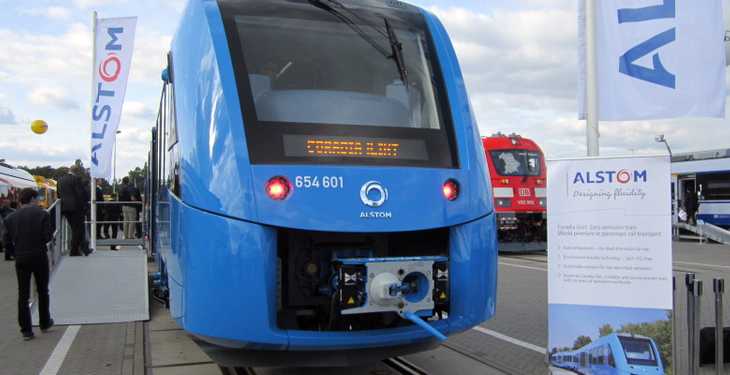Alstom successfully performed the first test run at 80 km/h of the world’s only fuel cell passenger train Coradia iLint on its own test track in Salzgitter, Lower Saxony (Germany). An extensive test campaign will be conducted in Germany and Czech Republic in the coming months before the Coradia iLint performs its first passenger test runs on the Buxtehude–Bremervörde–Bremerhaven–Cuxhaven (Germany) route beginning of 2018.
The four-week test runs currently undergoing in Salzgitter aim at confirming the stability of the energy supply system based on coordinated interaction between the drive, the fuel cell and the battery of the vehicle. The braking power is also being tested to check the interface between the pneumatic and the electric brake.
The Coradia iLint is the first low floor passenger train worldwide powered by a hydrogen fuel cell, which produces electrical power for the traction. This zero-emission train is silent and only emits steam and condensed water. Coradia iLint is special for its combination of different innovative elements: a clean energy conversion, flexible energy storage in batteries, and a smart management of the traction power and available energy. Based on Alstom’s flagship Coradia Lint diesel train, Coradia iLint is particularly suited for operation on non-electrified networks. It enables sustainable train operation while maintaining high train performance.
“This test run is a significant milestone in environmental protection and technical innovation. With the Coradia iLint and its fuel cell technology, Alstom is the first railway manufacturer to offer a zero-emission alternative for mass transit trains. Today our new traction system, so far successfully proved on the test ring, is used on a train for the first time – a major step towards cleaner mobility in Europe“, said Didier Pfleger, Vice President of Alstom Germany and Austria.
The dynamic tests are performed at Salzgitter plant at 80 km/h and in Velim (Czech Republic) at up to 140 km/h, the maximum speed of the Coradia iLint. For the purpose of the tests, a mobile filling station has been erected in Salzgitter to pump gaseous hydrogen into the pressure tank of the Coradia iLint. The hydrogen used for the test runs is the by-product of an industrial process, which is reasonably reused as a waste product. In the long term, Alstom aims to support the hydrogen production from wind energy.
The vehicle has already successfully completed the static commissioning process. All electrical and pneumatic functions of the trains have been tested and verified at standstill. TÜV Süd has certified the safety of the battery, the pressure tank system and the fuel cell for the coming test phases.
The Coradia iLint was designed by Alstom teams in Germany at Salzgitter’s site, centre of excellence for regional trains and in France notably in Tarbes, centre of excellence for traction systems and Ornans for the motors. This project benefits from the support of the German ministry of Transport and Digital infrastructure. Alstom has already signed letters of intent for 60 trains with the German states of Lower Saxony, North Rhine-Westphalia, Baden-Württemberg and the Hessian transport association ‘Rhein-Main-Verkehrsverbund’.
